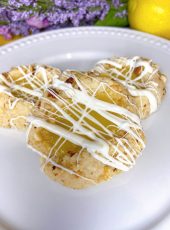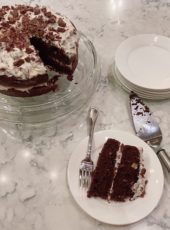Banoffee Pie – banana and toffee and whipped cream on a salted brown butter graham cracker crust – will challenge your assumptions about British desserts.
“Anyway, I didn’t invent it – it evolved.” – Ian Dowding
Mostly, when you hear “British desserts,” you’re not terribly excited. Taste Atlas even has an article called “The 10 Worst British Desserts.” As does BuzzFeed, whose version is even meaner, “18 of The Most Disgusting British Desserts That Need to Be Stopped.” Their list highlights some pretty unappealing names like “Spotted Dick” (a steamed cake with currants) and “Lardy Cake” (a cake made of animal lard – and currants). A Quora question on the matter asks, “Why do the British pour cream over all the desserts they eat?” The answer from most Brits seemed to be “because it’s delicious.” Ok, so their reputation on desserts may not be totally unfounded.
These days though, if we hear “British desserts,” we may actually think of something much more positive, The Great British Baking Show. The show’s popularity in the U.S. may seem confusing given the American disdain for British desserts. But as the LA Times has reported, the show offers a comforting departure from the viciousness of American reality TV. For instance, As Blake writes, “Contestants never say things like ‘I didn’t come here to make friends.” It’s also refreshing that contestants don’t compete for money. Blake continues, “That’s right: The winner of the Great British Baking Show wins a title and an engraved cake stand, and that’s it!”

According to the BBC, the show has another title in the UK, “The Great British Bakeoff.” It had to change its name to air in the U.S. because Pillsbury has trademarked the word “bakeoff.” This isn’t where our linguistic battles end. Americans are befuddled by several common British food terms. So much so that Libby Nelson penned a lovely article on the matter for Vox, “British desserts explained for Americans confused by the Great British Baking Show.”
She covers fascinating quirks, like that pudding has two meanings: a specific dish and a general course. The specific dish, pudding, isn’t the same as American pudding. American pudding is what the British would call a custard; British pudding is something that is cooked by being boiled or steamed. Since the word refers to a method of preparation rather than a savory or sweet course, the earliest puddings were sausages; blood pudding is a traditional English sausage made with, yes, blood. The general course of pudding is what Americans would call dessert. Its usage in the UK is actually telling of one’s class: “pudding” is used by elites while “sweets” is used by the working class.
The slight differences in meaning can make your head spin. Nelson quotes the Oxford Dictionary blog on the matter: “So you’ve got it, right? A British biscuit is an American cookie and an American cookie is a British cookie and an American biscuit is a British scone and an American scone is something else entirely. Simple!”

It is my personal belief that Banoffee, a combination of the words “banana and toffee,” is the most divine British dessert of all time. The flagship dish began in 1971 at a restaurant called The Hungry Monk, a posh restaurant started by newlyweds Nigel MacKenzie and Sue Kenrick in 1968. They converted a 16th-century building in East Sussex that formerly been inhabited by monks.
Ian Dowding, the Head Chef at The Hungry Monk, or as he tells it the only Chef, developed it from a recipe he’d learned of in his travels to the U.S. “Blum’s Coffee Toffee Pie” was a toffee poured into pastry crust and topped with coffee flavored whipped cream. The problem was sometimes the toffee was precarious. Sometimes it didn’t set and sometimes it was like concrete. In a casual conversation Dowding’s sister told him about a method of creating a silky toffee by boiling cans of condensed milk. He resurrected Blum’s Coffee Toffee Pie – and added bananas.
The time was right to do it. As Dowding has said, in the late 1960’s the “seeds of a food revolution were sprouting” and the British public was becoming aware that there was more to cuisine than “boiled beef and plum duff.” The popularity of Banoffee Pie exploded. But from Banoffee ice creams to cookies (or biscuits) to chocolates, neither Dowding nor Mackenzie have been paid for its use. Neither of them thought to trademark the name, and you don’t get paid for inventing a dish.
While I have espoused the splendor of this dessert, my version may upset its inventors. Mackenzie was particularly insulted by substitutions, especially “that horrible cream in aerosol cans,” and a biscuit base instead of the short-crust pastry. On the latter he threatened, “if you ever make it with a biscuit base, expect a lightning strike from above.” I do feel a little guilty, Nigel, but my salted browned butter graham cracker crust is just a perfect pairing with your pie.
Banoffee Pie
Recipe by MauraCourse: DessertDifficulty: Medium8-12
servings30
minutes3
hours10
minutes4-5
hoursIngredients
- Filling
14 oz sweetened condensed milk
3 ripe bananas
- Whipped Cream Topping
8 oz heavy whipping cream
3-4 TBSP brown sugar (to taste)
1/2 tsp vanilla extract
(optional) 2 TBSP sour cream (see note 2)
a chocolate bar for shaving on top of whipped cream
Directions
- Prepare crust and bake for 10 minutes at 350F
- For the Filling
- Prepare Dulce de Leche (the "toffee" filling): Using a deep saucepan, place unopened container of condensed milk in boiling water. Make sure the container is covered with water. Simmer, uncovered, for 3 hours. It’s very important to make sure the can is covered by water for the entire cooking process. (Otherwise a very scary explosion could happen!) As long as you go low and slow and keep the can covered, you should be fine, but there are other methods to achieve the toffee filling, if you prefer. Whisk to remove any lumps. Allow to cool slightly before spreading on graham cracker crust.
- Spread Dulce de Leche mixture on graham cracker crust.
- Slice bananas and spread them in a layer over the Dulce de Leche layer.
- For the Whipped Cream Topping
- Using a stand mixer and whisk attachment, blend on medium high speed with sugar, vanilla, and sour cream. It should take 3-5 minutes to come together. Be careful not to over blend - it could turn into butter! Whipped cream is finished when you see soft peaks that hold when the whisk is turned up, but the edges should still be soft.
- Spread on banana slice layer. Next, shave chocolate bar on top of whipped cream. You can use a vegetable peeler if you'd like large peel-like slices. I used a citrus zester to achieve tiny shavings.
- Chill in the refrigerator for 3-4 hours so the pie can set.
Notes
- Note 1: You can also make Dulce de Leche by scratch, with milk, sugar, and baking soda. I find that this hands off version is just as satisfying and dependable.
- Note 2: Sour cream is not necessary for taste or consistency. It will make it a bit thicker and add a slight tart taste. I use it to mellow out the sweetness of the whipped cream.





